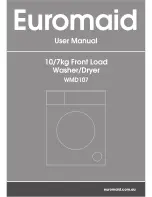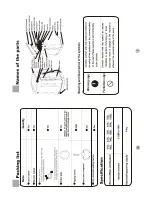
2.9 GPM @ 2,500 PSI Electric Wall-Mount Pressure Washer
10
For technical questions call 1-800-665-8685
8242273
V 2.9
WASHING BEST PRACTICES
1. Organize the work to be done. Unwrap as much of the pressure hose as required. Position the washer out of the
way of the spray.
2. Be sure the safety latch is in position under the trigger.
3. Hold the spray wand with both hands and aim it at the work. The force of the water leaving the nozzle can move
the wand.
4. Move the safety latch out of the way and squeeze the trigger.
5. If less working pressure is required, turn the unloader knob counter-clockwise to reduce the system pressure.
Never turn the unloader knob clockwise past the factory preset. The factory preset is set to maximum pressure.
6. The spray gun can be turned to any angle and the water will always flow through the selected nozzle, provided
the trigger is not released.
CAUTION: Do not put hands or fingers in front of the nozzle and do not point the nozzle at people or animals.
7. If chemical cleaning additives are required, refer to the Using Detergent section.
8. If the gun must be laid down, engage the safety latch near the trigger. Turn the motor off if the washer will be
unattended for longer than 1-2 minutes.
9. On walls, siding, grain bins, etc., always apply the detergent from the bottom up and rinse from the top down.
10. On flat areas, do not attempt to soap and rinse too much at once. Clean approximately 10 x 10 ft
(3 x 3 metre) sections.
11. In or on buildings that may have considerable wiring, such as milk-houses, do not spray near wiring. You could
be electrocuted.
12. Your machine will remove peeling and blistering paint quite easily. Use the fan shaped spray as you would a flat
scraper; the nearer the nozzle is to the surface, the more powerful the jet of water.
13. When removing grease and dirt from a tractor engine, use “shampoo” detergents that are available for this
purpose. After waiting for a few minutes (or according to the shampoo directions), use your high-pressure
spray to rinse off the engine. In the case of gasoline engines, it is usually necessary to cover the distributor with
some plastic, or better still, remove the entire ignition harness before covering and spraying.
14. High-pressure spray is perfect for removing dead bugs from engine radiators. However, be careful when
cleaning not to bend the radiator fins. If this happens, move the nozzle further from the radiator and straighten
any damaged fins after washing.
15. When cleaning any electrical machinery such as a chop mill, bale elevators, etc., remember to disconnect their
power cords first. Although their motors and wiring are designed for outdoor use, rain will not enter connection
boxes the way a high-pressure jet of water would.











































